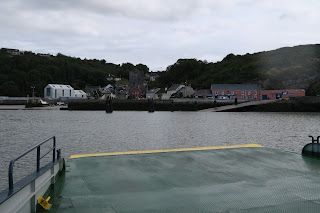Strongbow passed here on his way to capture Waterford in 1170, reputedly instructing his men to land ‘by Hook or by Crooke’ (the latter referring to the nearby settlement of Crooke) - the origin of the popular phrase.
Rather than backtracking along the main highway all the way to New Ross, I decided that my travels to Hook Peninsula would start with a ferry ride across the River Barrow, from Passage East over to Ballyhack on the peninsula.
Good-bye to East Passage
Across the River Barrow
To Ballyhack
The little white one at the end was my transportation for this part of my Ireland travels
South from Ballyhack is Duncannon which has a beautiful sandy beach.
On its southern tip, Hook Head is capped by the world’s oldest working lighthouse, a modern light flashing atop a 13th-century tower. The tower was built by Strongbow’s son-in-law William Marshall, Earl of Pembroke, who had a 36m high tower built at the mouth of Waterford Harbour. The exact year of construction of the current tower isn’t known, but Pembroke first came to the region in 1201 and the first map that shows the lighthouse serving its function is dated 1240, so construction must have taken place between these dates.
Hook Lighthouse is one of the most fascinating examples of medieval architecture in Ireland. The tower stands four storeys high with walls up to 4m thick. The old light-keepers cottages have now been turned into a visitor centre.
And the view from the top of the lighthouse is pretty spectacular!
Today you can clearly see where the River Barrow is emptying into the Irish Sea
Looking north up the peninsula
A Welsh monk named Dubhan established a monastery on this site in the fifth century and the peninsula became known as Rinn Dubhain. As dubhan also means ‘a hook’ this was later anglicized as Hook Head. The medieval church dates to the thirteenth or fourteenth century and many interesting stone details still survive.
Dating from the 14th century, and rebuilt in the 1870s, Loftus Hall is reputed to be one of the most haunted houses in Ireland. The first castle was built on the site in 1170 by the Norman Knight Raymond Les Gros who changed his surname to Redmond to adopt an Irish identity. The Redmond family built the Hall in 1350 during the time of the Black Death to replace the castle. It then became known as Redmond Hall and stayed in the Redmond family until the 1650s when it was given to the Loftus family who were English planters, as part of the Cromwellian conquest. Redmond Hall then became Loftus Hall. The building that exists today was heavily renovated between 1872 and 1879 in preparation for a visit from her majesty Queen Victoria. Unfortunately the Queen’s visit never happened and the Loftus family was left with a massive debt following all of the work.
Loftus Hall stands alone and austere on the bleak landscape. For many years it is said to have been visited by the Devil, so many people from the surrounding area are nervous to enter the place after dark. The are some amazing ghost stories associated with Loftus Hall - far too many and too lengthy for me to write about here. I guess you’ll just have to visit!
After the Norman Invasion of Ireland in 1169, Henry II granted large sections of land on the Hook Peninsula to The Knights Templar and they built the medieval tower at Templetown. For how long the tower was in use is vague but in the early 19th century a new church was built alongside it and the tower adapted as a sacristy for the minister of the Church of Ireland. It remained in use until the mid 1800s and was then abandoned when the congregation moved to another church. The ruins here today are a bit of a mish-mash. There are only scant remains of the original Templar Church but the medieval tower is quite impressive. The old 19th century church has all of its walls standing but is completely roofless.
In addition to all these ‘destinations’ on Hook Peninsula, there is simply the gorgeous scenery as you’re driving along.
As I said - Irish weather, always unpredictable!
On the way back to Waterford, leaving Ballyhack behind and crossing back over the River Barrow




































No comments:
Post a Comment